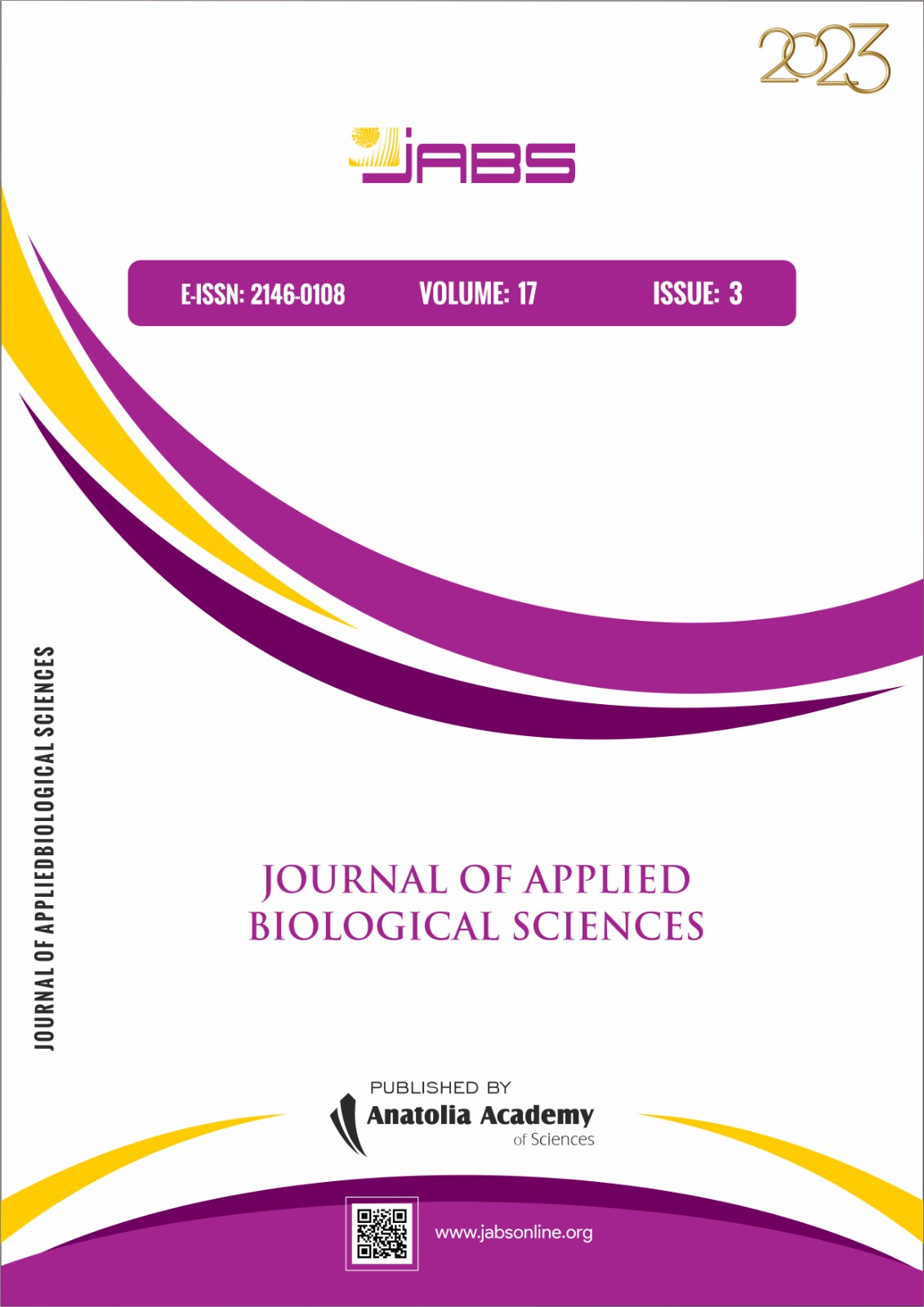UNKNOWN AGENT IN MARES: CHLAMYDIA ABORTUS
DOI:
https://doi.org/10.71336/jabs.1259Keywords:
Abortion, chlamidya abortus, mare, real time pcr, zoonosesAbstract
Chlamydia abortus is a gram-negative, obligate intracellular pathogen. The causative agent causes infections by affecting the urogenital system in humans and many animals due to its zoonotic character. It has been reported that C. abortus previously developed forms characterized by abortion in sheep and goats. Studies on horses from farm animals are very rare in our country and in the world. The aim of this study was to investigate the molecular prevalence of C. abortus in mares. For our research, vaginal swab samples were collected from 123 mares from farms in different settlements in Turkey. Samples were tested by real time PCR method. As a result of the test, a total of 4 (3.25%) samples were evaluated as C. abortus positive. As a result of the evaluation, in the analysis of variance with the 95% confidence interval, it was determined as 1.0577 for Marmara, 1.0233 for Southeast Anatolia, and 1.0000 for the Eastern Anatolia region. The presence of this agent, which is very difficult in culture isolation, was demonstrated in mares by molecular diagnosis. According to this result, it was concluded that it would be beneficial to take precautions against C. abortus infections in horse farms as in other farm animals. At the same time, our study is one of the rare studies in which C. abortus infection was investigated by real time PCR in mares genital swap samples. It will also contribute to further studies to determine the presence of infection in mares to understand the transmission cycle. It should not be forgotten that this agent, which is zoonotic and causes abortions, may also carry a risk for people working in horse farms and having a history of contact.
References
Karadaş, İ,, Keskin, O. (2021): Determination of Chlamydia abortus Seropositivity in Arabian Thoroughbred Horses in Şanlıurfa. Erciyes Üniv Vet Fak Derg. 18(3): 226-230 (article in Turkish). DOI: https://doi.org/10.32707/ercivet.1019563
Rubio-Navarrete, I,, Mostes-de-Oca-Jimenez, R,, Acosta-Dibarrat, J., Monroy-Salazar, HG., Morales-Erasto, V,, Fernandez-Rosas, P,, Elghandour, MMMY,, Odongo EN. (2017): Prevalence of Chlamydia abortus Antibodies in Horses from the Northern State of Mexico and Its Relationship With Domestic Animals. Journal of Equine Veterinary Science 56:110-113. DOI: https://doi.org/10.1016/j.jevs.2017.05.004
Semeniuk, H., Zentner, A., Read, R., Church, D. (2002): Evaluation of sequential testing strategies using non-amplified and amplified methods for detection of Chlamydia trachomatis in endocervical and urine specimens from women. Diagnostic Microbiology and Infectious Disease 42,1, 43-51. DOI: https://doi.org/10.1016/S0732-8893(01)00315-7
Dhawan, B., Rawre, J., Ghosh, A., Malhotra, N., Ahmed, M. M., Sreenivas, V., Chaudhry, R. (2014): Diagnostic efficacy of a real time-PCR assay for Chlamydia trachomatis infection in infertile women in north India. The Indian Journal of Medical Research 140(2), 252.
Turin, L., Surini, S., Wheelhouse, N., Rocchi, M.S. (2022): Recent advances and public health implications for environmental exposure to Chlamydia abortus: from enzootic to zoonotic disease. Veterinary Research 53: 3. DOI: https://doi.org/10.1186/s13567-022-01052-x
Pantchev, A., Sting, R., Bauerfeind, R., Tyczka, J., Sachse, K. (2009): New real-time PCR tests for species-specific detection of Chlamydophila psittaci and Chlamydophila abortus from tissue samples. The Veterinary Journal 181(2), 145-150. DOI: https://doi.org/10.1016/j.tvjl.2008.02.025
Schachter, J., Stamm W.E, Quinn, T.C. (1996): Discrepant analysis and screening for Chlamydia trachomatis. Lancet 348:1308–1309. DOI: https://doi.org/10.1016/S0140-6736(05)65783-2
Van Der Pol, B., Liesenfeld, O., Williams, J.A., Taylor, S.N., Lillis, R.A., Body, B.A., Nye, M., Eisenhut, C., Hook III, E.W. (2012): Performance of the Cobas CT/NG test compared to the Aptima AC2 and Viper CTQ/GCQ assays for detection of Chlamydia trachomatis and Neisseria gonorrhoeae. J Clin Microbiol 50:2244–2249. DOI: https://doi.org/10.1128/JCM.06481-11
Wilsmore, A.J., Parsons, V., Dawson, M. (1984): Experiments to demonstrate routes of transmission of ovine enzootic abortion. Br Vet J 140: 380–391. DOI: https://doi.org/10.1016/0007-1935(84)90130-1
Longbottom, D., Coulter L.J. (2003): Animal chlamydioses and zoonotic implications. J Comp Pathol 128: 217–244. DOI: https://doi.org/10.1053/jcpa.2002.0629
Watson, E.J., Templeton, A., Russell, I., Paavonen, J., Mardh P.A., Stary, A., Pederson, B.S. (2002): The accuracy and efficacy of screening tests for Chlamydia trachomatis: a systematic review. J Med Microbiol 51:1021–1031. DOI: https://doi.org/10.1099/0022-1317-51-12-1021
Meijer, A., Brandenburg, A., de Vries, J., Beentjes, J., Roholl, P., Dercksen, D. (2004): Chlamydophila abortus infection associated with indirect contact with infected goats in a pregnant woman. Eur J Clin Microbiol Infect Dis 23 :487–490. DOI: https://doi.org/10.1007/s10096-004-1139-z
CFSPH ve IICAB Zoonotic Chlamydiae Maintained in Mammals; Chlamydiosis (2017): 32. http://www.cfsph.iastate.edu/Factsheets/pdfs/chlamydiosis.pdf
Baumann, S., Gurtner, C., Marti, H., Borel, N. (2020): Detection of Chlamydia species in 2 cases of equine abortion in Switzerland: a retrospective study from 2000 to 2018. Journal of Veterinary Diagnostic Investigation 32 (4): 542-548. DOI: https://doi.org/10.1177/1040638720932906
Forster, J.L., Wittenbrink, M.M., Häni, H.J., Corboz, L., Pospischil, A. (1997): Absence of Chlamydia as an aetiological factor in aborting mares. Vet Rec 141:424. DOI: https://doi.org/10.1136/vr.141.16.424
Szeredi, L., Hotzel, H., Sachse, K. (2005): High prevalence of chlamydial (Chlamydophila psittaci) infection in fetal membranes of aborted equine fetuses. Vet Res Commun 29(1):37–49. DOI: https://doi.org/10.1007/s11259-005-0835-1
Ricard, R. M., Burton, J., Chow-Lockerbie, B., Wobeser, B. (2023): Detection of Chlamydia abortus in aborted chorioallantoises of horses from Western Canada. Journal of Veterinary Diagnostic Investigation 10406387231171844. DOI: https://doi.org/10.1177/10406387231171844
Nervo, T., Nebbia, P., Bertero, A., Robino, P., Stella, M.C., Rota, A., Appino, S. (2019): Chronic endometritis in subfertile mares with presence of Chlamydial DNA. J Equine Vet Sci 73:91–94. DOI: https://doi.org/10.1016/j.jevs.2018.12.003
Qin, S.Y., Huang, S.Y., Yin, M.Y., Tan, Q.D., Liu, G.X., Zhou, D.H., Zhu, X.Q., Zhou, J.Z., Qian, A.D. (2015): Seroprevalence and risk factors of Chlamydia abortus infection in free-ranging white yaks in China. BMC Veterinary Research 11,1, 1-5. DOI: https://doi.org/10.1186/s12917-015-0323-y
Downloads
Published
How to Cite
Issue
Section
License
Copyright (c) 2023 Journal of Applied Biological Sciences

This work is licensed under a Creative Commons Attribution-NonCommercial-NoDerivatives 4.0 International License.


